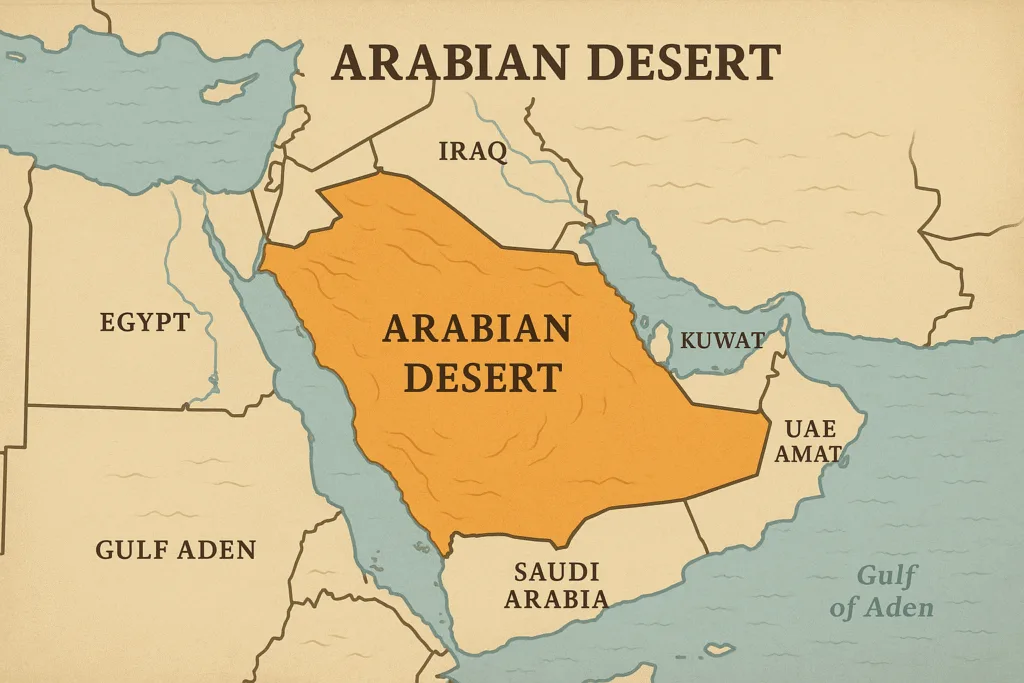Location & Continent
Continent: Asia
Country: Pakistan (Balochistan Province)
Coordinates: near Kharan town ≈ 28°35′N, 65°25′E
Physical Features
Area: Estimates vary (~20,000–48,000 km²); the desert occupies much of Kharan District and adjacent basins.
Length: Broad E–W spread across western Balochistan within the Kharan Basin.
Width: Narrower N–S span bounded by the Ras Koh and Siahan ranges.
Elevation: Basin floor ~500–900 m; surrounding ranges rise to ~2,760 m in the wider ecoregion.
Climate & Precipitation
Climate Type: Hot to cold desert transition (Köppen BWh/BWk depending on elevation).
Temperature: Very hot summers; winter nights can be near or below 0°C at higher elevations.
Precipitation: Hyper-arid; deserts typically receive <300 mm annually, with far lower totals common in the Kharan Basin.
Ecological Features
Ecozone: Palearctic
Biome: Deserts and xeric shrublands
Ecoregions: Registan–North Pakistan Sandy Desert (PA1326); Baluchistan Xeric Woodlands (PA1307)
Flora & Fauna
Flora: Sparse xerophytic shrubs (e.g., tamarisk and salt-tolerant bushes), ephemeral grasses after rare rains, and halophytic (salt-loving) plants around dry lake beds.
Fauna: Desert reptiles and small mammals adapted to extreme aridity; regionally, species such as the chinkara (Indian gazelle) and the sand cat occur in Balochistan’s deserts.
Geology & Notable Features
Geology: The Kharan Basin sits between the Makran accretionary prism to the south and the Chagai magmatic arc to the north, with broad sandy plains, gravel regs, and dry playas.
Notable Features: Hamun-e Mashkel (seasonal desert lake) on the basin’s western side; Ras Koh Range and Kharan Dunes area (site of Pakistan’s Chagai-II underground nuclear test on 30 May 1998).
Introduction
The Kharan Desert, located in the southwestern region of Pakistan, is a striking example of an arid landscape that intrigues both scientists and adventurers alike. Spanning an area of approximately 30,000 square kilometers, this desert is characterized by its unique geological features, climate, and biodiversity. In this article, we will delve into the geography, climate, and biodiversity of the Kharan Desert, and compare it with other notable deserts around the globe.
Geography
The Kharan Desert is situated primarily in the Balochistan Province of Pakistan. It borders the Iranian frontier to the west and boasts a unique geological formation comprising vast plains and rugged mountains. The desert lies at elevations between 1,500 and 2,500 meters above sea level. Its terrain is marked by scattered sand dunes, rocky plateaus, and intermittent salt flats known as kharans.
Topographical Features
The topography of the Kharan Desert features distinct landforms, including:
- Sand Dunes: Expansive areas of shifting sands.
- Rocky Plateaus: Elevated flat lands providing unique ecosystems.
- Salt Flats: Crusts that form from evaporated water, hosting minimal flora and fauna.
Climate
The climate of the Kharan Desert is predominantly arid with extreme temperature variations throughout the year. Summers can reach scorching temperatures above 40°C (104°F), while winters see temperatures plummeting to -6°C (21°F) at night. The region receives minimal annual rainfall, often averaging around 100-150 mm per year.
Weather Patterns
Understanding the weather patterns of the Kharan Desert is essential for researching its ecosystems:
| Month | Average High (°C) | Average Low (°C) | Rainfall (mm) |
|---|---|---|---|
| January | 16 | 1 | 15 |
| April | 28 | 10 | 5 |
| July | 39 | 23 | 0 |
| October | 30 | 12 | 10 |
Biodiversity
The biodiversity in Kharan Desert, despite its harsh environment, is fascinating. The region supports a variety of flora and fauna adapted to its extreme conditions. Key species found include:
- Acacia plants, which are drought-resistant.
- Gazelles and desert foxes are notable mammals living in this arid region.
- A variety of reptiles, including lizards and snakes that thrive in sandy terrain.
Comparative Analysis with Other Deserts
The Kharan Desert can be compared with other prominent deserts to highlight its uniqueness:
| Desert Name | Location | Area (sq km) | Avg Temperature (°C) |
|---|---|---|---|
| Kharan Desert | Pakistan | 30,000 | -6 to 40 |
| Sahara | Africa | 9,200,000 | 18 to 40+ |
| Gobi | Mongolia/China | 1,295,000 | -40 to 40 |
Conclusion
In summary, the Kharan Desert presents a remarkable case study of resilience and adaptation within one of the world’s most challenging climates. Its disparate landscapes, coupled with its unique biodiversity, offer much to explore both for researchers and adventurous travelers. By comparing it with other deserts, we gain a greater appreciation for the ecological significance and geographical diversity found across our planet.
References
Kharan Desert — Wikipedia
Chagai-II (nuclear test) — Wikipedia
Registan–North Pakistan Sandy Desert — Wikipedia
NASA Earth Observatory — Desert Biome
NOAA NCEI — Climate Data Online
USGS — Chagai Arc / regional geology (Open-File Report 2010-1099)
European Commission JRC — DOPA Explorer (Registan–North Pakistan ecoregion)
FAQ
Where is the Kharan Desert?
In southwest Pakistan’s Balochistan Province, centered west–southwest of Kharan town in a large endorheic (closed) basin.
What makes it historically significant?
Pakistan’s second underground nuclear test, Chagai-II, was conducted in the Kharan Desert on 30 May 1998.
How dry is it?
It is hyper-arid. Deserts generally receive less than 300 mm of rain annually; the interior Kharan Basin typically gets far less.
Which ecoregions cover the area?
The desert core falls within the Registan–North Pakistan Sandy Desert ecoregion, with flanking uplands belonging to the Baluchistan Xeric Woodlands.
Are there notable landforms?
Yes — broad sand sheets and regs, dry playas like Hamun-e Mashkel, and bordering ranges such as Ras Koh and Siahan.
What wildlife lives there?
Specialist desert reptiles and small mammals; regionally the chinkara and sand cat occur in Balochistan’s deserts where conditions allow.


